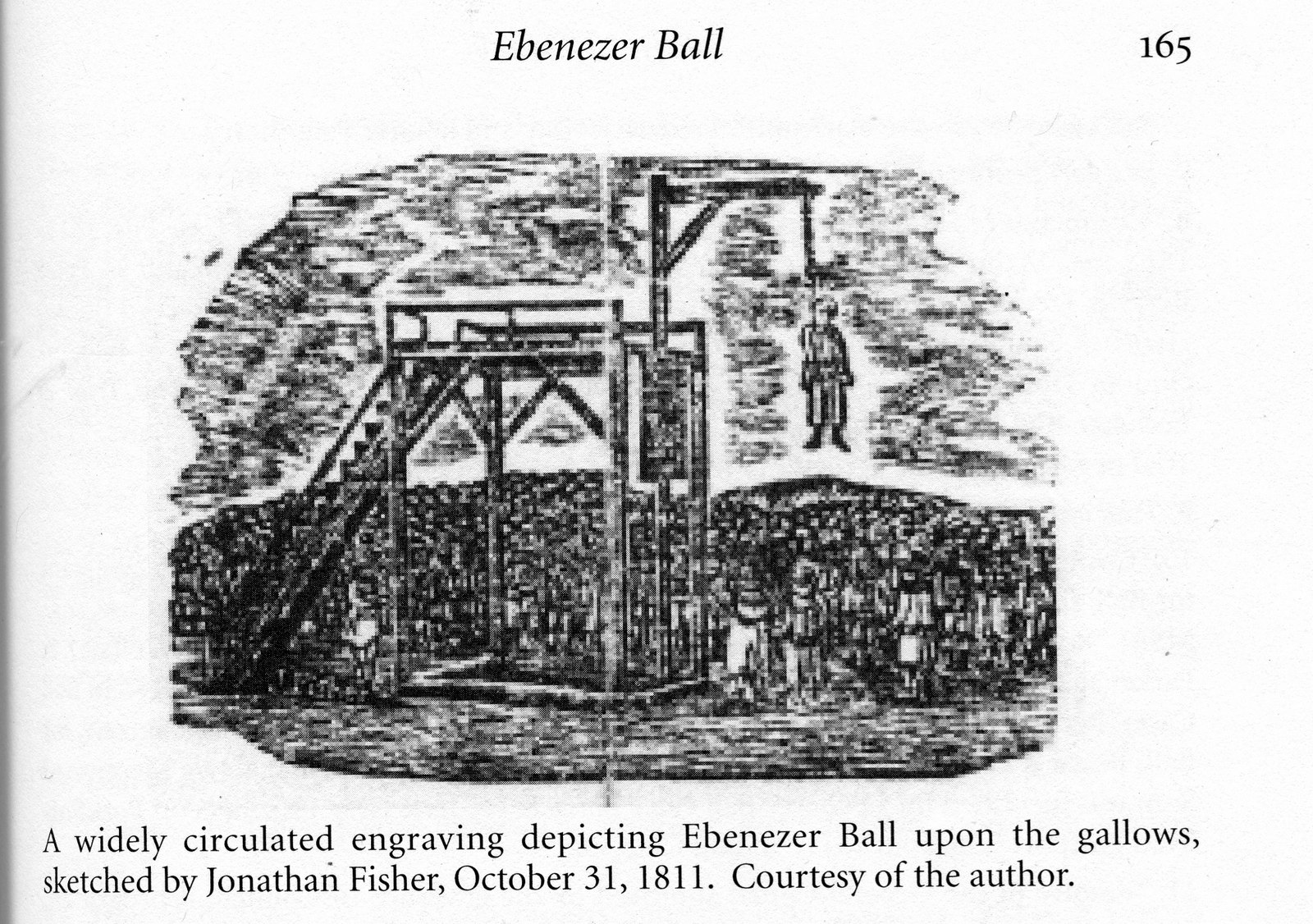
1500 people watched the hanging of Ebenezer Ball of Robbinston in 1811
“Ball was veiled and conducted upon a scaffold, with a rope hitched to a hook over his head. The sheriff gave him a cloth and told him to throw it when he was ready. He held it a minute, then dropped it, when the support under his feet was removed, and launched him into eternity. When turned off, he fell about 5 ft., and died with hardly a struggle.”
Thus did Parson Jonathan Fisher describe the execution of Ebenezer Ball of Robbinston in 1811 at Castine, the first execution in the Eastern District of Maine. Parson Fisher went on to say Ball “When warned of the danger of falling into Hell, he said there was no Hell but what was in this world. As he lived, so he died,” said Fisher, “an example of uncommon hardness of heart.”
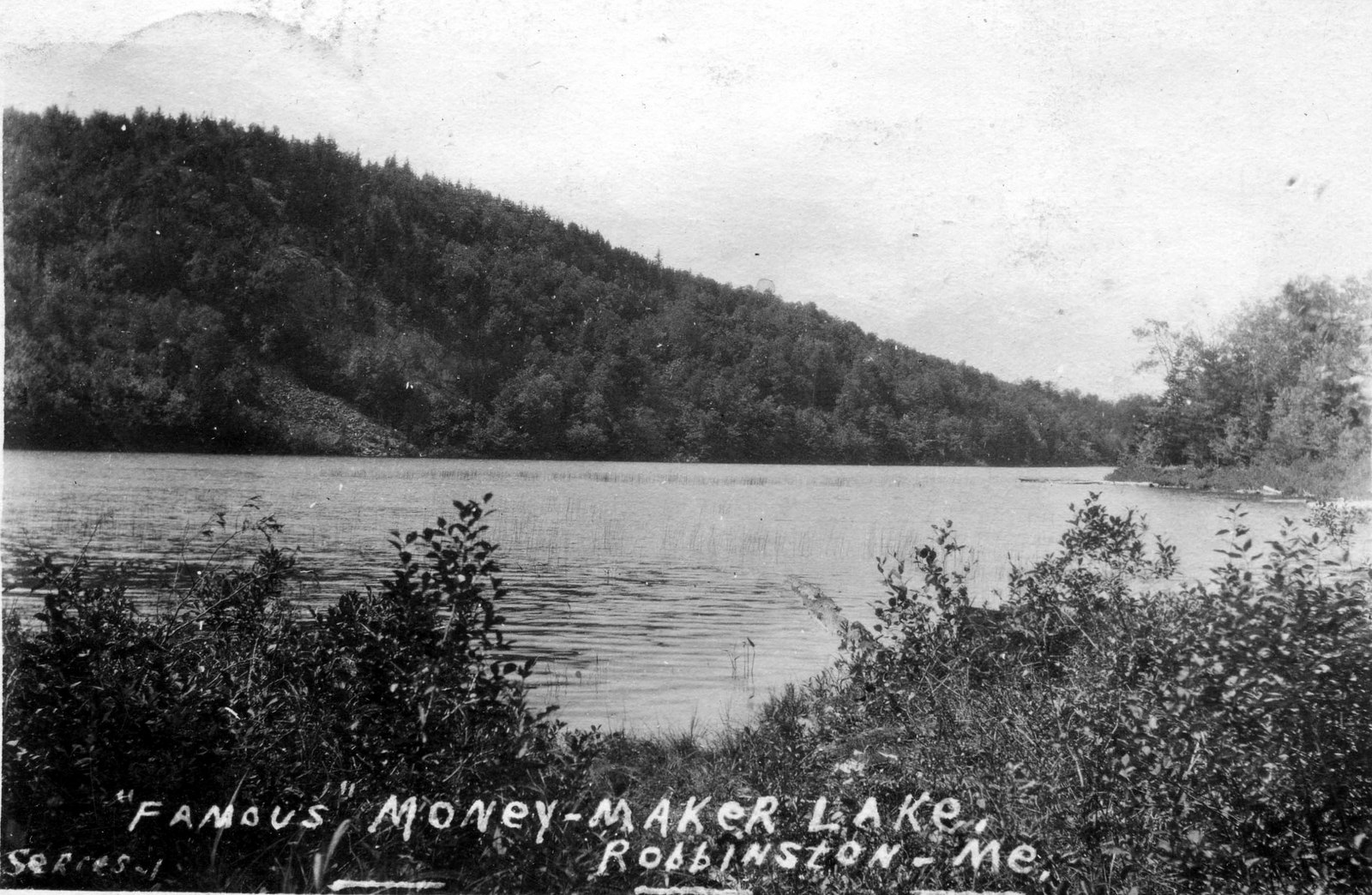
The Counterfeiters camp was on the hill to the left
Most know of Money Maker Lake in Robbinston and many have no doubt visited what remains a pretty, largely unspoiled lake reached by a woods road at the end of the Shattuck Road. The lake acquired its name over 200 years ago when, as noted by Scotsman Patrick Campbell then visiting Downeast, “the area was inhabited by a band of Yankey smugglers who lived on contraband trade.”
Our eminent historian Ned Lamb gives a short version of the events in an article published in the Portland Sunday Telegram in 1955:
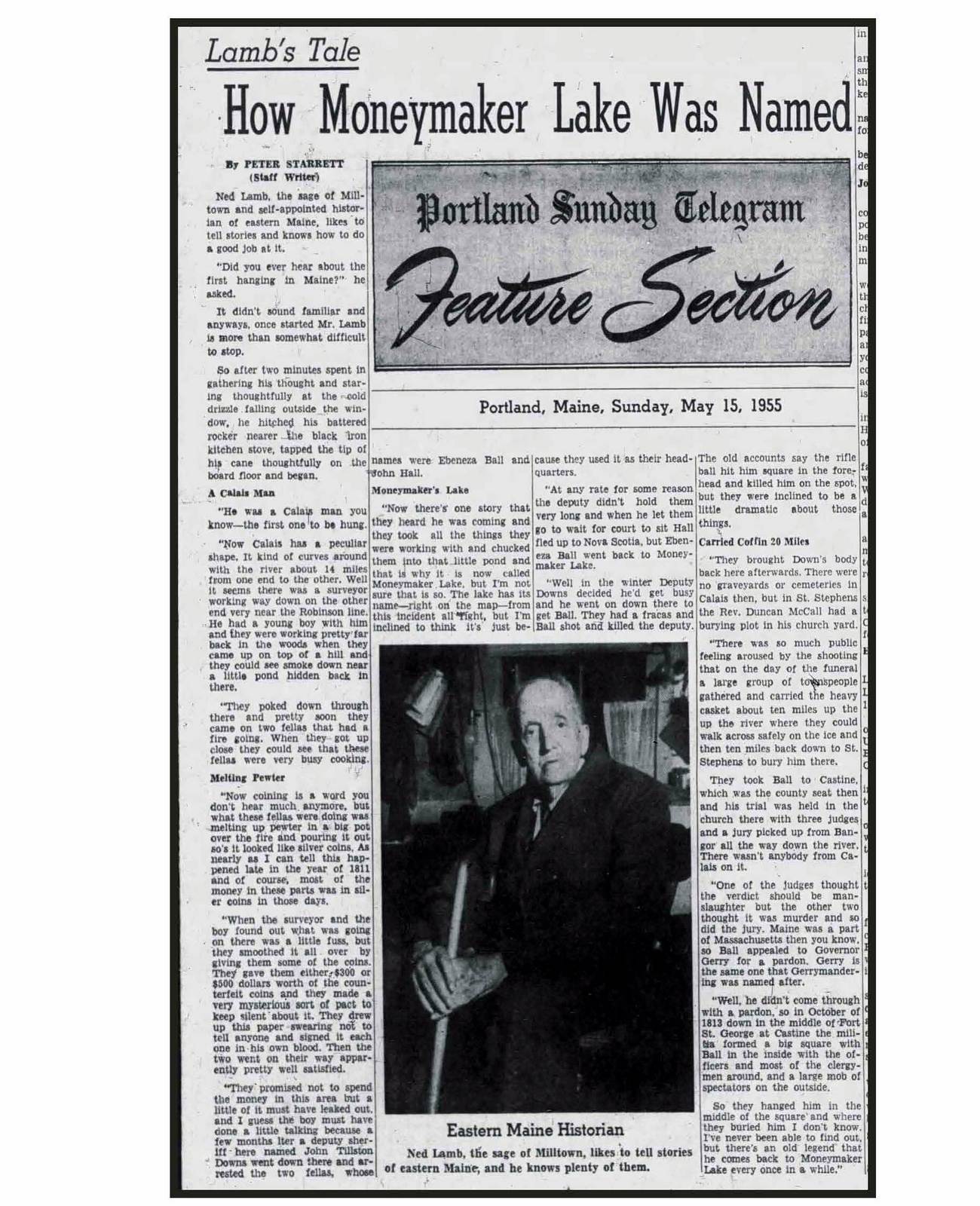
Ned Lamb from Milltown, noted Downeast historian
Lamb’s Tale
How Moneymaker Lake Was Named
PETER STARRETT (Staff Writer)
Ned Lamb the sage of Milltown and self-appointed historian of Eastern Maine likes to tell stories and knows how to do a good job it.
“Did you ever hear about the first hanging in Maine?”’ he asked’
It didn’t sound familiar and anyways once started Mr. Lamb is more than somewhat difficult to stop.
So after two minutes spent in gathering his thought and staring thoughtfully! at the cold drizzle falling outside the window he hitched his battered rocker nearer the black iron kitchen stove, tapped the tip of his cane thoughtfully on the board floor and began.
A Calais Man
“He was a Calais man you know— the first one to be hung!
“Now Calais has a peculiar shape. It kind of curves around with the river about 14 miles from one end to the other. Well, it seems there was a surveyor working way down on the other end very near the Robbinston line. He had a young boy with him and they were working pretty far back in the woods when they came up on top of a hill and they could see smoke down near a little pond hidden back there.
“They poked down through there end pretty soon they came on two fellas that had fire going. When they got up close, they could see that these fellas were very busy cooking.
Melting Pewter
“Now coining is a word you don’t hear much anymore but what these fellas were doing was melting up pewter in a big pot over the fire and pouring it out so’s it looked like silver coins. As nearly as I can tell this happened late in the year of 1811 and of course most of the money in these parts was in silver coins in those days.
“When the surveyor and the boy found out what was going on there was a little fuss, but they smoothed it all over by giving them some of the coins. They gave them either $300 or $500 dollars’ worth of the counterfeit coins and they made a very mysterious sort of pact to keep silent about it. They drew up this paper -swearing not to tell anyone and signed it each one in his own blood. Then the two went on their way apparently pretty well satisfied.
They promised not to spend the money in this area but a little of it must have leaked out and I guess the boy must have done a little talking because few months later a deputy sheriff here named John Tillston Downs went down there and arrested the two fellas whose names were Ebenezer Ball and John Hall.
Moneymaker’s Lake
Now there’s one story that they heard he was coming, and they took all the things they were working with and chucked them into that little pond and that is why it is now called Moneymaker Lake but I’m not sure that is so. The lake has its name— right on the map— from this incident but I’m inclined to think it’s just because they used it as their headquarters.
“At any rate for some reason the deputy didn’t hold them very long and when he let them go to wait for court to sit Hall fled up to Nova Scotia, but Ebenezer Ball went back to Moneymaker Lake.
“Well in the winter Deputy Downs decided he’d get busy and he went on down there to get Ball. They had a fracas and Ball shot and killed the deputy.
The old accounts say the rifle ball hit him square in the forehead and killed him on the spot but they were inclined to be a little dramatic about those things.
Carried Coffin 20 miles
“They brought Downs’ body back here afterwards. There were no graveyards or cemeteries in Calais then but in St Stephens the Rev Duncan McCall had a burying plot in his church yard.
“There was so much public feeling aroused by the shooting that on the day of the funeral a large group of townspeople gathered and carried the heavy casket about ten miles up the where they could walk across safely on the ice and ten miles back to St. Stephen where they could bury him there.
They took Ball to Castine which was the county seat then and his trial was held in the church there with three Judges and a Jury picked up from Bangor all the way down the river- There wasn’t anybody from Calais on it.
“One of the Judges thought the verdict should be manslaughter but the other two thought it was murder and so did the jury. Maine was a part of Massachusetts then you know so Ball appealed to Governor Gerry for a pardon. Gerry is the same one that Gerrymandering was named after.
Well, he didn’t come through with a pardon so in October of 1811 down in the middle of Port St. George at Castine the military formed a big square with Ball in the inside with the officers and most of the clergy around and a large mob of spectators on the outside.
So, they hanged him in the middle of the square and where they buried him I don’t know and I’ve never been able to find out but there’s an old: legend that he comes back to Moneymaker Lake every once in a while.”
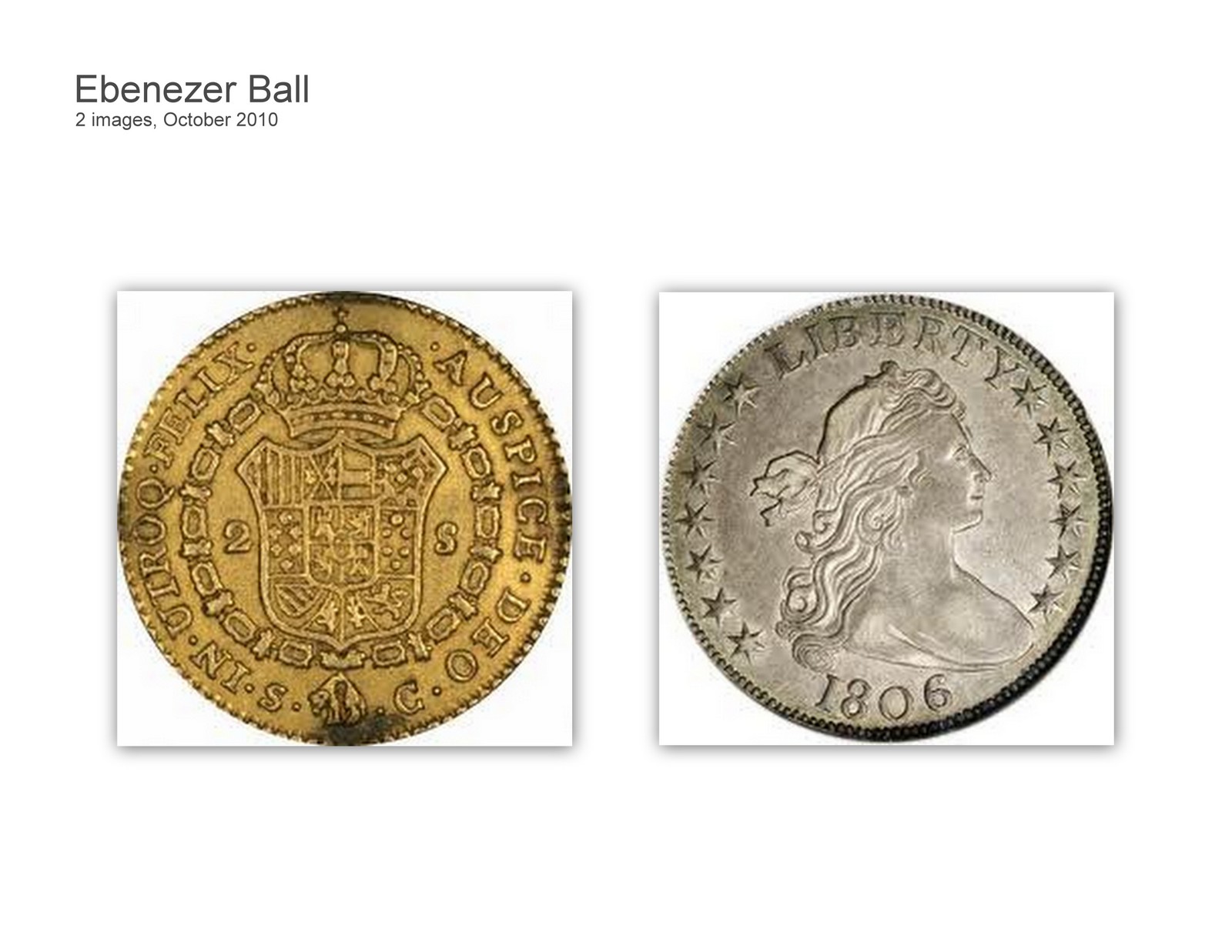
A Spanish coin and American Dollar
Indeed, Ball and his associates(the number of his accomplices varies from account to account) became more careful after their encounter with surveyor Sam Jones at the lake, but we do know for certain at least one took up residence in Nova Scotia when things got hot. Sam Jones by the way was a well respected Robbinston man who lived on Mill Cove. He was also, however, well connected with the Calais Downes family and no doubt a friend of the Deputy John Downes. “Coining” as their activity was described in those days was a very profitable business. There was little “money” as we know it and trade was carried on largely in foreign coins, such as Spanish doubloons. American dollars were in very short supply but there was a severe shortage of all coin which counterfeiters such as Ebenezer Ball sought to remedy by producing a pewter coin and dipping it in gold or silver. A reasonable facsimile of the face and back of a real coin was pressed onto the counterfeit and used in trade, often by mixing a few counterfeit coins with real coins.
We won’t attempt a complete factual and legal history of the Ebenezer Ball case. Many articles have been written about the case, the most complete was done by William Welch, a Massachusetts historian who often summered at Brooks Bluff in Robbinston. It was published in the Maine Historical Society magazine in June of 2010.
Ned Lamb’s article in 1955 was only one of many published in the newspapers over the years.

Typical is an article published in the Summerfield Kansas Sun and dozens if not hundreds of national newspapers in 1920:
Summerfield Kansas Sun December 22, 1920
Strangers Seek Buried Treasure
Hidden a Century Ago by Counterfeiters on Shore of Lake in Maine.
OLD EPISODE IS RECALLED
Gang Worked In Secret for Many Years, but Refrained From Passing Any of Their Product in the Neighborhood.
Bangor Me. -The fact that a fortune lies buried in the dense forest somewhere along the shores of Moneymaker Lake, between Robbinston and Red beach, well-nigh forgotten by the few residents of that section who ever knew It, has again been brought to mind.
A Robbinston farmer lad, having strayed some distance from home in search of trout brooks, which might furnish better sport than those nearer the settlements, came upon two men digging under some giant spruce trees near the shores of Moneymaker Lake.
The men did not observe him at first and he watched them while they toiled in two or three spots. Later, the boy accosted them and they told him they were digging for worms for bait. They had no fishing tackle with them and as Moneymaker Lake has no fish worth catching, the boy thought this explanation somewhat remarkable. When he reached home he told of his adventure, and at first none could account for the presence of strangers or for their actions until one of the older residents of the town declared his belief that the two unknown men were seeking the buried treasure which had lain in secret for almost a century and has defied the efforts of treasure seeker for years.
Long ago many men labored diligently along the shores of the lake, but the search was abandoned, and until this week no one had been known to have hunted for the treasure for a quarter of a century.
Moneymaker Lake is surrounded by a heavy forest growth and is a somewhat inaccessible place in northern Washington County. It derived its name from a gang of counterfeiters who, early in the nineteenth century, dwelt in a cabin on the shore of the lake and pursued their unlawful employment of making money, chiefly imitations of silver coin.
Later their names were known to be Ball, Smith and Blaisdell. Here they lived for many years in secrecy until one day, almost a century ago, a Robbinston farmer, looking for some cattle which had strayed from his pasture, came upon their cabin unawares and discovered the nature of their employment. He was seized by the three lawbreakers and carried into their cabin. Ball, the leader of the gang, was in favor of killing the visitor to make sure that there would be no evidence against them.
If Smith had not strongly objected Hall probably would have killed the farmer but Smith was determined that the crime of murder should not be his, and a compromise was effected. The farmer was obliged to swear by the must binding oath that he would not reveal his discovery, and was then permitted to go
The farmer, after his return home, hesitated between the fear of the counterfeiters and his sense of duty for a day or two and then told the town authorities what had befallen him and what he had discovered.
Deputy Sheriff Dow started for the forest at once along the route described by the farmer. Before reaching the cabin of the counterfeiters the officer came upon Ball, who was doing sentry duty. Deputy Downes, a courageous man, advanced upon Ball. The latter fired, bringing down the officer at the first shot. Other officers later captured Hall, but Smith and Blaisdell escaped and have never been heard from since. Ball was tried, convicted of murder and was executed.
Before his death by hanging the counterfeiter said a large sum of money had been hidden by him at the foot of a tree near his cabin, but he defied any one to find it, and refused to tell its exact location. He said most of the money was in genuine silver coin, the spurious money having been distributed elsewhere. As soon as the story became known, and for many years after, hundreds tried vainly to find the hidden hoard.
It seemed that every couple of decades the national press would revive the story with embellishments and generally fictional accounts of the events. The farmer boy is one of these fictions. There is no question Ebenezer Ball was discovered by Sam Jones, a local surveyor and his assistant although accounts of the “deal” made between the counterfeiters and Jones vary considerably.

One aspect of the case is its importance in the history of Castine. It is remembered in Castine for the trial and the execution which was attended by 1500. Interest in the case was intense and a lengthy moralistic poem was circulated by broadsheet throughout the Northeast after the execution.
Children who witnessed the execution were “tortured by the memory of the gruesome events.”
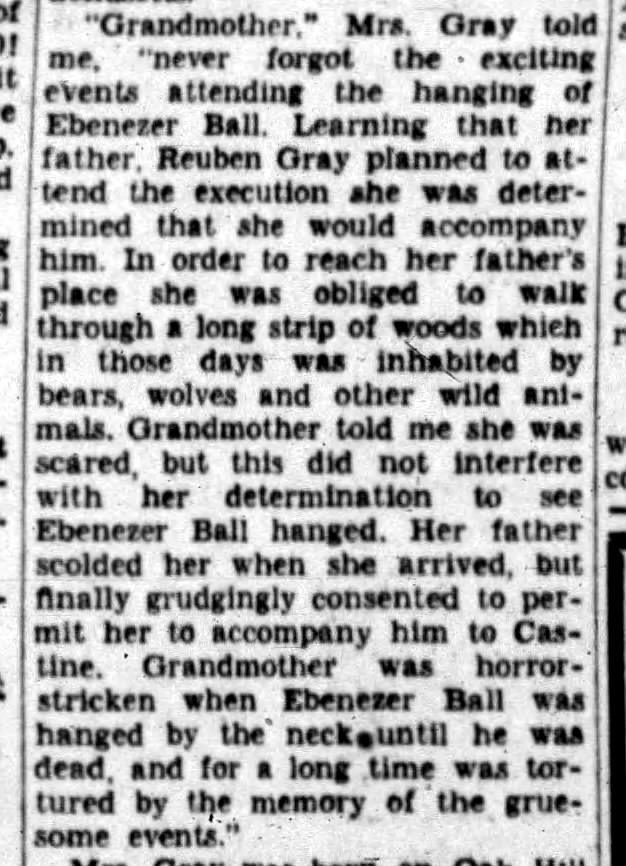
Children in Castine feared walking by the spot where the gibbet had been erected:

Lewiston Sun Journal 1915
The hanging was even commemorated in a quilt made by a witness to the hanging:
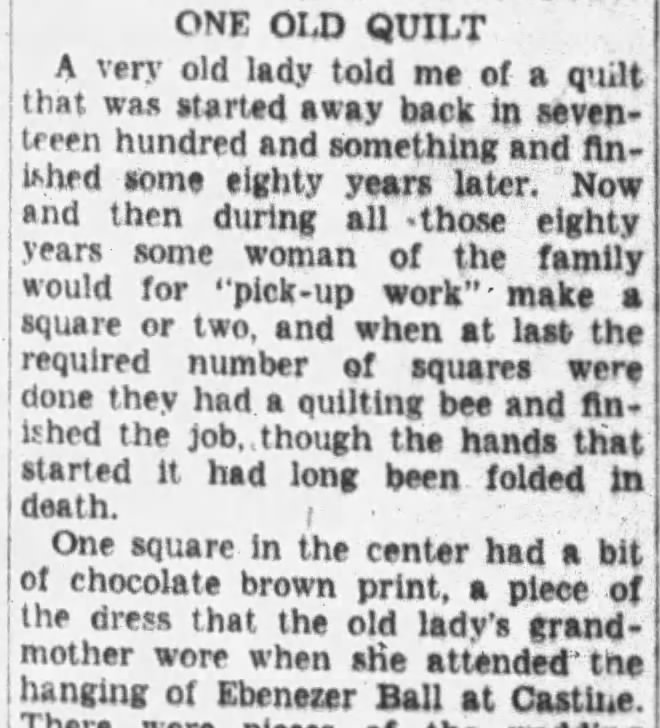
1930 Bangor Daily News
Locally Fred Keene, who grew up in a couple of miles from the lake in Red Beach in the late 1800’s recalls searching for the treasure in the hill above the lake with his friends and even searching the lake for the counterfeiter’s equipment which legend claims they hastily discarded in the lake after being discovered by Sam Jones the surveyor.
There was the Counterfeiters Trail, leading to Moneymaker’s Lake. Always there was an air of mystery about this silent lake. We could not see where it emptied, although we knew that it ran finally into the Intervale, it was always stiller there than anywhere else. The mountain ran sharply down into the water; the trout were infected with lice; there was a cave where Ball plied his false trade and finally killed the sheriff of Washington County; for which he was hanged by the neck until dead. The water was deep. Tradition said that off the Cave there had been dumped the presses and dies that stamped out the bad coinage. I have sounded and trawled but never could raise anything that looked like machinery; nothing but dead cedar stubs.
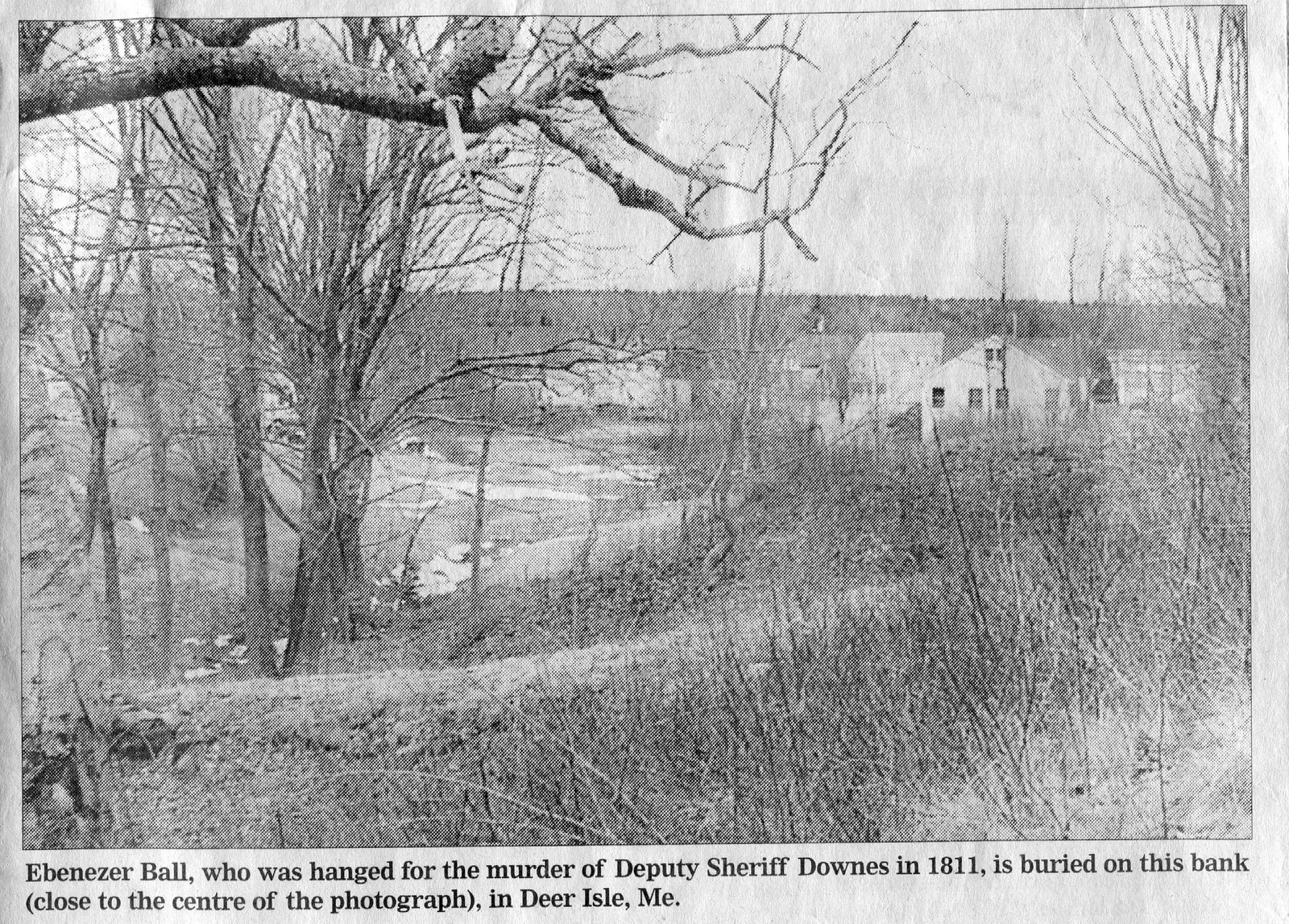
Ned Lamb says he did not know where Ebenezer Ball was buried. In fact, we know he asked from the scaffold to be buried on Deer Island and his grave can be found there.
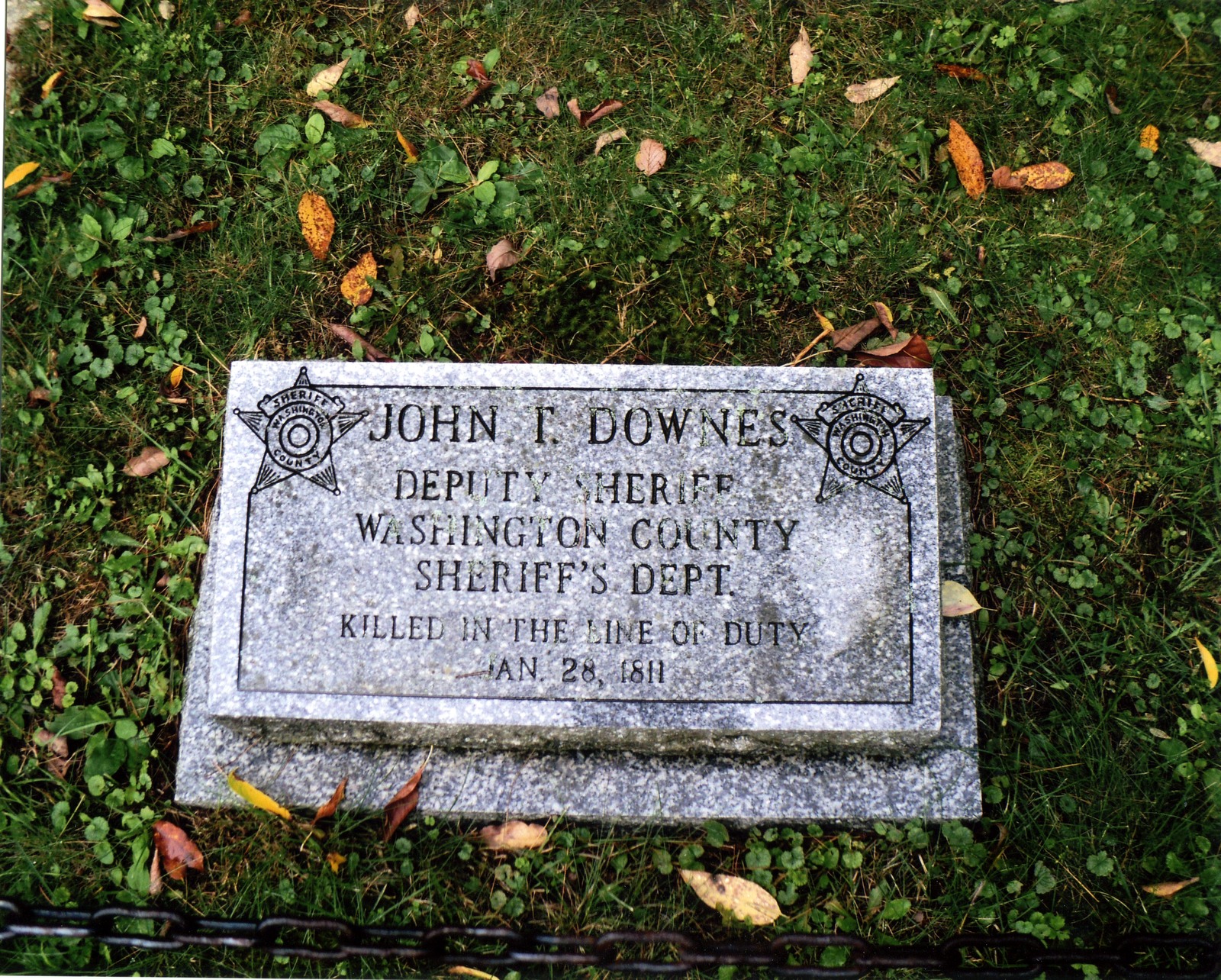
John T Downes Grave
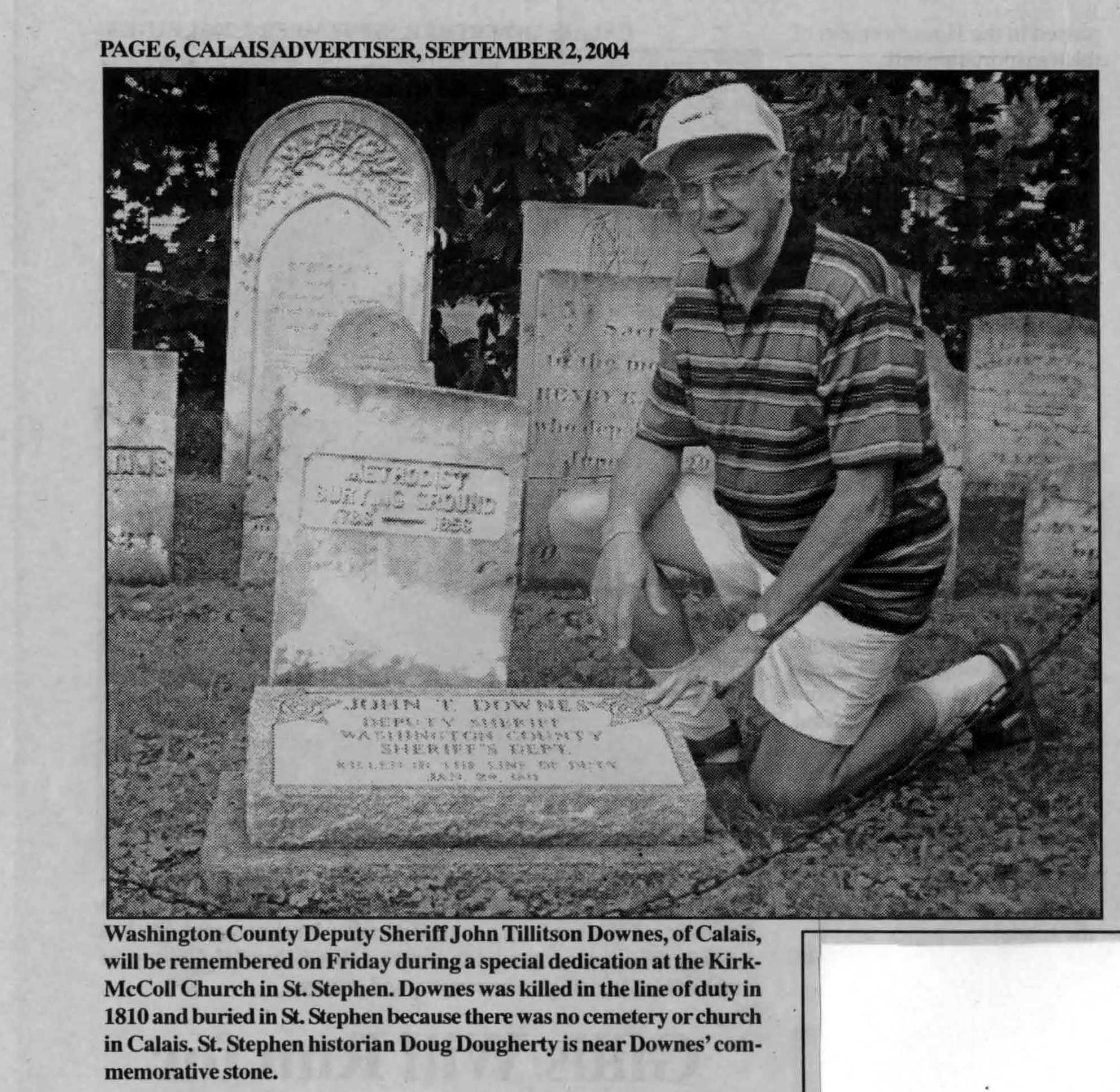
Sheriff Downes was buried in the small cemetery in the back of the Kirk McColl Church on King Street in St. Stephen. The stone had deteriorated over the years and was replaced in 2004 with a new stone.
A final note – William Welch’s well researched and written history of the case raises serious questions about the fairness of the trial of Ebenezer Ball. Ball was not allowed to testify in his own defense nor was he allowed a continuance to procure witnesses to testify for him. Further the witness who “hanged” Ball was Annaniah Bohanon, son of John Bohanon a close friend and business associate of the Calais Downes family. Bohanon testified to a chance encounter with Ebenezer Ball on the Calais road just after the shooting, an encounter Ball denied. Bohanon says Ball told him he had shot a deputy who was trying to arrest him for counterfeiting and “I have blown one damn bugger’s brains out and meant to do it.” This provided the “malice aforethought” required to elevate a killing from manslaughter to murder but this “chance” encounter is odd in several respects. Ball knew Bohanon and would certainly not have made such an incriminating statement to a friend of the victim. Further Bohanon was then on the run himself for failure to pay a judgment and was hiding out in St. Stephen. After he agreed to testify against Ball the warrant went away and his financial problems miraculously disappeared.
There is no question Ball was guilty of homicide but as one of three judges at the trial argued the offense was manslaughter, not murder. Manslaughter was not a hanging offense.
